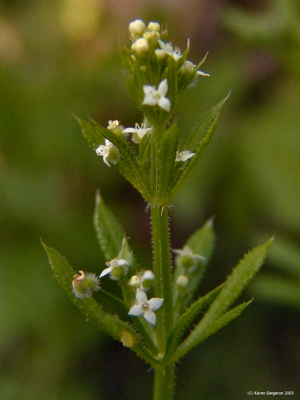Galium aparine
| See Also | Botanical Monographs |
|---|
Cleavers (Galium aparine) has historically been used to treat nodular growths of the skin and mucous membranes that could be found on or under the skin. To explore the characteristics, medicinal uses and prescribing considerations of this herb in more detail, check out the references indicated. [1], [2]
Contents
Characteristics
- Common Names: Cleavers, Bed straw
- Family: Rubiaceae
- Habitat: Galium aparine is native to Europe and is now naturalized in gardens and moist thickets in North America.
- Parts Used: Aerial parts
- Constituents: organic acids, iridoid glucosides, tannins
- Medicinal Actions: alterative, refrigerant, diuretic, antinodular, diuretic depurative, hepatic, laxative, lymphatic, tonic, vulnerary
Uses
Historical Uses:
Galium aparine was historically used to treat ulcers and nodular growths of the skin and mucous membranes that could be found on or under the skin.
Medicinal Uses:
Internal
- lymphadentis (lymph node infection) anywhere in the body, nodular growth of skin and mucous membranes (on or under the skin often with mucous), tonsillitis (especially involving the adenoids)
- Exanthem Diseases:
- Urinary tract conditions that are associated with pain, such as anuria induced by stones, kidney, and bladder inflammation, and scalding urination associated with Neisseria gonorrhea.
External
- Dry skin conditions such as psoriasis, eczema, or lichen planus (use as a rinse or wash)
- Nodular conditions such as cancer nodules or scrofula (tubercular infection of the lymph nodes of the neck)
Prescribing Considerations
The information provided is intended to augment the treatment from a naturopathic doctor or other trained medical professional. Although most herbs are generally safe, it is recommended that you avoid self-prescribing especially when there is an underlying ongoing medical condition, if you are on any prescription medications or if you are pregnant or breastfeeding.
Formulations and Preparation
- Tincture - 30-60 drops (25% alcohol) three times daily
- Juice/succus - 3-15mL three times daily
- Tea/infusion - 2-4g infused in 60-120mL of water Sig. three times daily
Safety
The safety and prescribing considerations for this herb include: [3] [4]
- Generally regarded as safe.
- Side-effects are generally not seen.
- Drug-Herb Interactions have not been reported.[2]
References
- ↑ Boon Heather, Smith Michael (2009) 55 Most Common Medicinal Herbs, Second Edition Institute of Naturopathic Education and Research, CCNM Toronto.
- ↑ 2.0 2.1 Godfrey Anthony, Saunders Paul, Barlow Kerry, Gowan Matt (2011) Principles and Practices of Naturopathic Botanical Medicine, Advanced Botanical Medicine. V3 CCNM Press, Toronto.
- ↑ Stargrove Mitchell Bebell, Treasure Jonathan, McKee Dwight L (2008) Herb, Nutrient, and Drug Interactions, Clinical Implications and Therapeutic Strategies.
- ↑ Brinker Francis (1997) Herbal Contraindications and Drug Interactions: Plus Herbal Adjuncts With Medicines, 4th Edition Eclectic Medical Publications.
